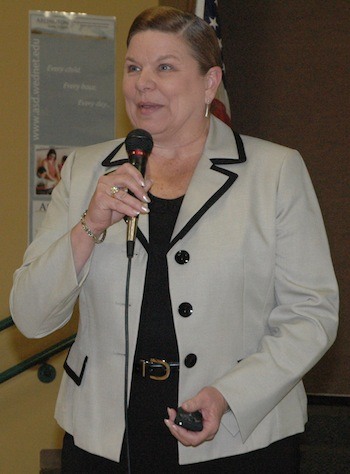ARLINGTON — Superintendent Dr. Kris McDuffy presented a portrait of the Arlington School District as adjusting capably to a community that’s changed significantly over the course of the past decade, during her State of the District address on Thursday, Jan. 30.
While the district’s current enrollment is down from its pre-recession peak in the 2007-08 school year, it’s held relatively steady at slightly more than 5,100 for the 2012-13 and 2013-14 school years. At the same time, its ethnic students have increased from 10 percent in 2004 to 19.4 percent in 2014, as opposed to the current state percentage of 40.9 percent, and its free and reduced lunch students have increased from 22 percent in 2004 to 32.7 percent in 2014, as opposed to the current state percentage of 46.1 percent.
“It’s important that we understand the needs of who we’re serving,” said McDuffy, who proudly touted the district’s average of 11.4 years of experience among its teachers, 26 of whom are National Board Certified, and whose turnover rate is less than 2 percent. “We have a very stable staff, earning qualifications that are very difficult to receive.”
McDuffy began listing what the district deems its essential priorities by citing its concern with “every child, every hour, every day,” before describing how the district’s “Guaranteed Viable Curriculum” is designed to explicitly identify standards for students in various grade levels, subjects and units, summaries of which are available as family resources from the district itself.
“If their child is in, say, the third grade, parents should be able to know what students are expected to know in every area,” said McDuffy, who explained that the district is seeking to improve its instruction not only through the Danielson framework of four domains of teaching — planning and preparation, the classroom environment, instruction itself and professional responsibilities — but also by applying Washington state’s eight new criteria for teacher evaluations.
McDuffy identified the district’s four critical questions for its instructional Professional Learning Communities as follows:
1. What do students need to know and be able to do?
2. How will we know when they have learned it?
3. What will we do when they have not learned it?
4. What will we do when they already know it?
“The schools belong to the community,” McDuffy said, as she cited the growth of the district’s fund balance from 0.3 percent in 2008 to 10.99 percent in 2013 as evidence of its stewardship of taxpayer dollars, and pointed out that both Post Middle School and Arlington High School have been named Schools of Distinction for at least two years each. “For too many years, the state was not meeting its paramount duty to fund basic education, but in the wake of the McCleary decision, we’re seeing some significant changes.”







